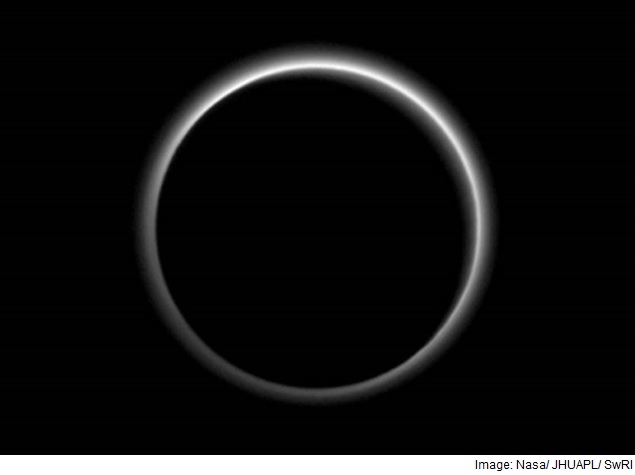- Home
- Science
- Science News
- Nasa's New Horizons Probe Shows Pluto Wrapped in Haze, Ice Flows
Nasa's New Horizons Probe Shows Pluto Wrapped in Haze, Ice Flows

New Horizons became the first spacecraft to visit Pluto and its entourage of moons and so far has returned about 5 percent of the pictures and science data collected in the days leading up to, during and immediately following the July 14 flyby.
The latest batch of images includes a backlit view of Pluto with sun, located more than 3 billion miles away, shining around and through the planet's atmosphere.
Analysis shows distinct layers of haze in Pluto's nitrogen, carbon monoxide and methane atmosphere. The haze extends at least 100 miles (161 km) off the surface.
"This is our first peek at weather in Pluto's atmosphere," New Horizons scientist Michael Summers, with George Mason University in Fairfax, Virginia, told reporters during a teleconferenced press briefing.
As the tiny particles fall to the ground, they may trigger chemical reactions that give Pluto its reddish hue, he added.
The haze layer, which extends five times farther than predicted by computer models, was not the only surprise. Pressure measurements show the total mass of Pluto's atmosphere has halved in two years.
"That's pretty astonishing, at least to an atmospheric scientist. That tells you something is happening," Summers said.
More details will come over the next year as New Horizons sends recorded data back to Earth.
Nasa also released new images of Pluto's surface, with telltale signs of a wide range of geologic activities including a Pluto version of glacial ice flows.
With surface temperatures just shy of 400 degrees below zero Fahrenheit (-235 degrees Celsius), Pluto is too cold for the ice to be made of water. Instead, Pluto's surface ice consists mostly of nitrogen.
"We knew that there was nitrogen ice on Pluto ... and we imagined that nitrogen was sublimating, or evaporating, in one place and condensing in another place. But to see evidence for recent geologic activity is simply a dream come true," said New Horizons scientist William McKinnon, with Washington University in St. Louis.
"Recent" in geological terms does not mean yesterday, he added. Based on the lack of impact craters, scientists suspect the surface of Pluto is less than a few hundred million years old, a fraction of the solar system's 4.6 billion year age.
© Thomson Reuters 2015
Catch the latest from the Consumer Electronics Show on Gadgets 360, at our CES 2026 hub.
Related Stories
- Samsung Galaxy Unpacked 2025
- ChatGPT
- Redmi Note 14 Pro+
- iPhone 16
- Apple Vision Pro
- Oneplus 12
- OnePlus Nord CE 3 Lite 5G
- iPhone 13
- Xiaomi 14 Pro
- Oppo Find N3
- Tecno Spark Go (2023)
- Realme V30
- Best Phones Under 25000
- Samsung Galaxy S24 Series
- Cryptocurrency
- iQoo 12
- Samsung Galaxy S24 Ultra
- Giottus
- Samsung Galaxy Z Flip 5
- Apple 'Scary Fast'
- Housefull 5
- GoPro Hero 12 Black Review
- Invincible Season 2
- JioGlass
- HD Ready TV
- Laptop Under 50000
- Smartwatch Under 10000
- Latest Mobile Phones
- Compare Phones
- Samsung Galaxy A07 5G
- Vivo Y500i
- OnePlus Turbo 6V
- OnePlus Turbo 6
- Itel Zeno 20 Max
- OPPO Reno 15 Pro Mini 5G
- Poco M8 Pro 5G
- Motorola Signature
- Lenovo Yoga Slim 7x (2025)
- Lenovo Yoga Slim 7a
- Realme Pad 3
- OPPO Pad Air 5
- NoiseFit Pro 6R
- Xiaomi Watch 5
- Acerpure Nitro Z Series 100-inch QLED TV
- Samsung 43 Inch LED Ultra HD (4K) Smart TV (UA43UE81AFULXL)
- Asus ROG Ally
- Nintendo Switch Lite
- Haier 1.6 Ton 5 Star Inverter Split AC (HSU19G-MZAID5BN-INV)
- Haier 1.6 Ton 5 Star Inverter Split AC (HSU19G-MZAIM5BN-INV)
















